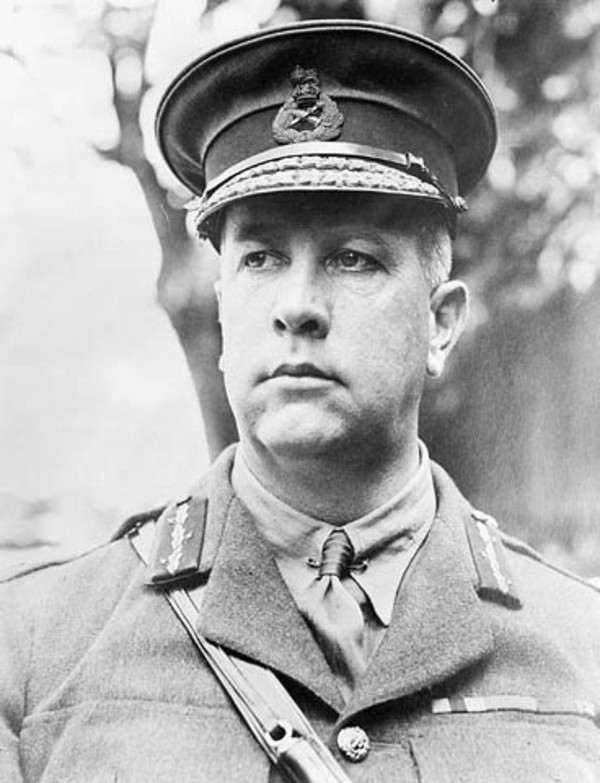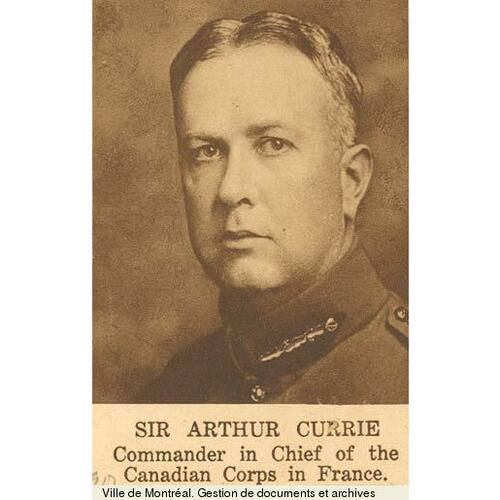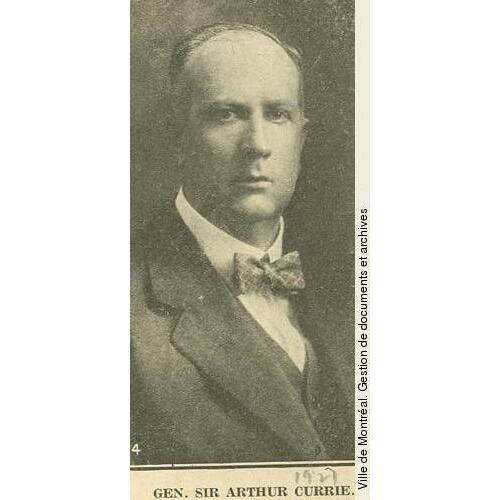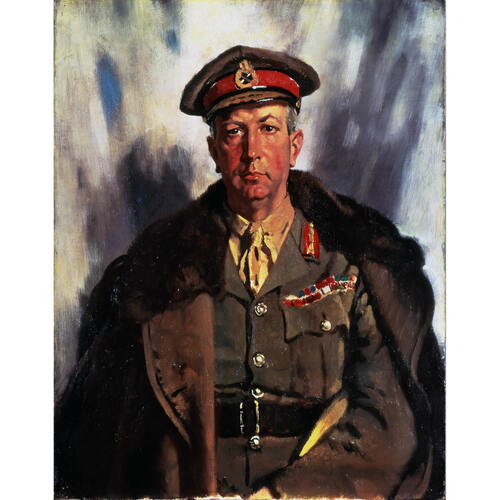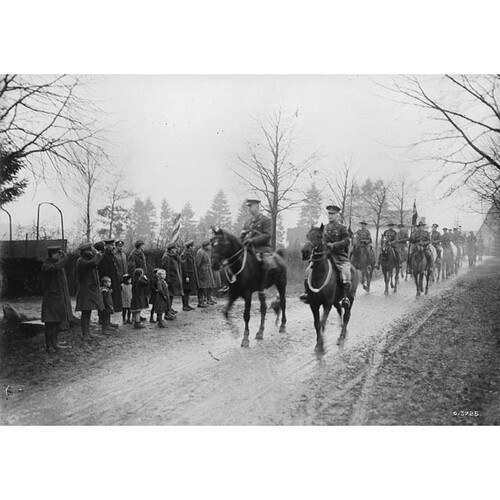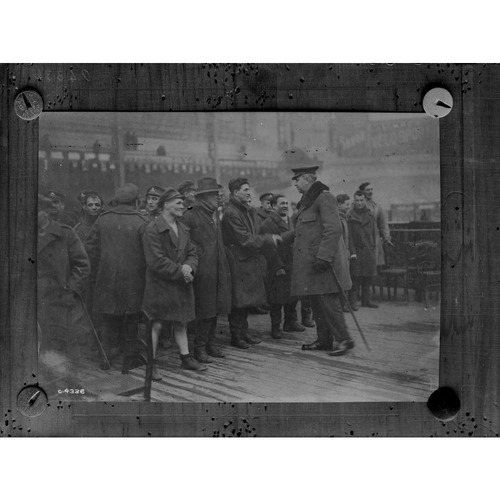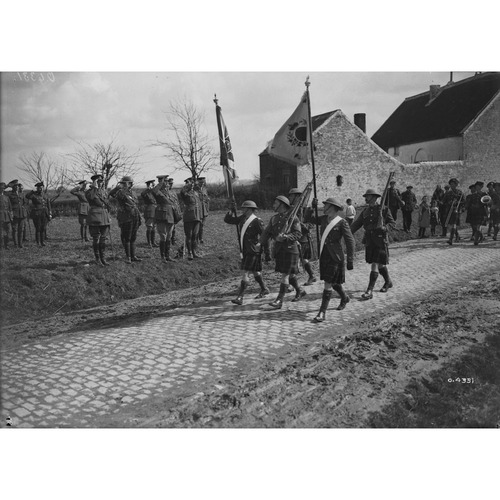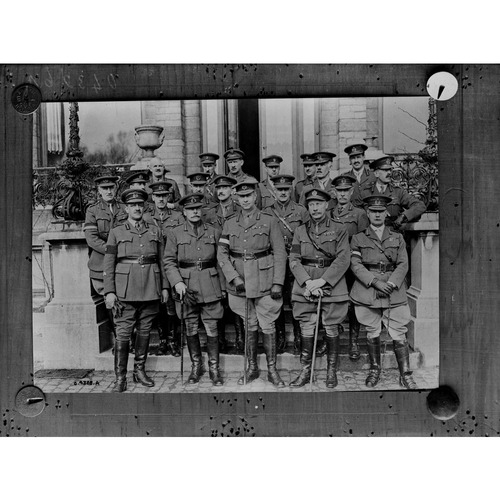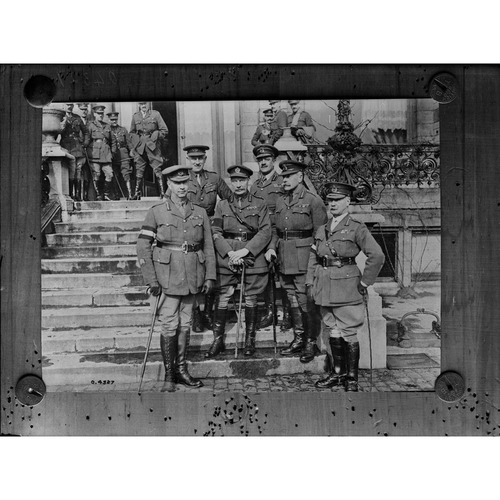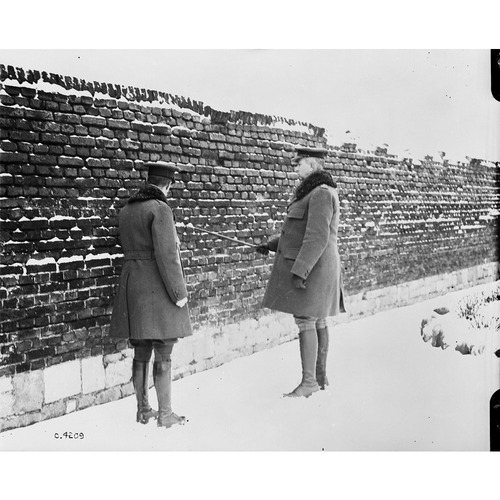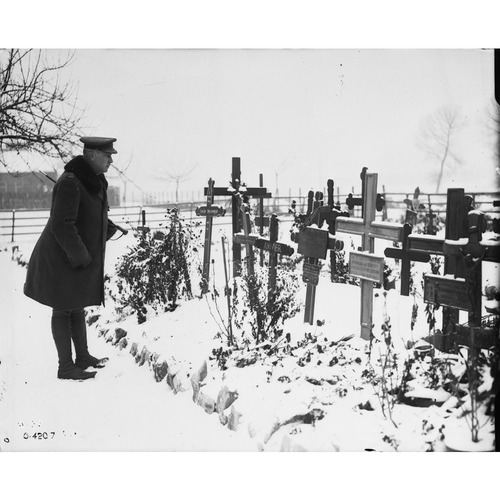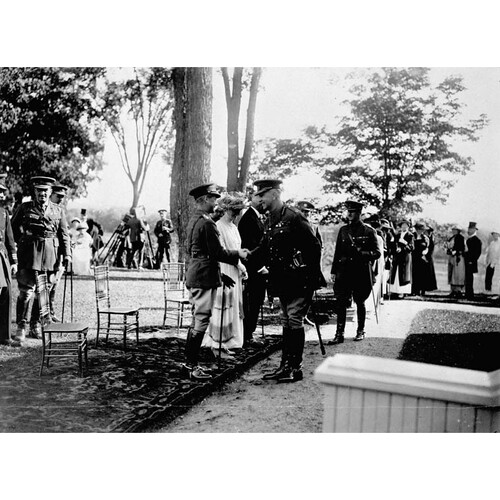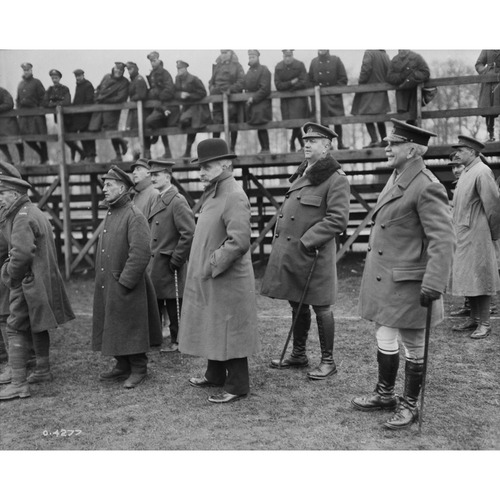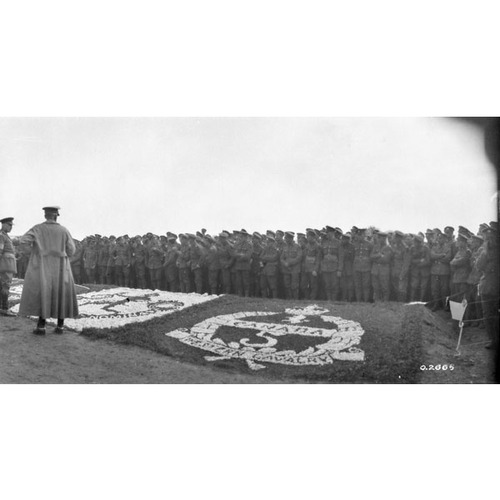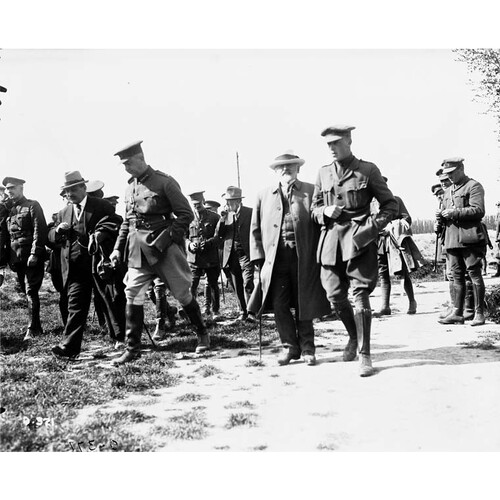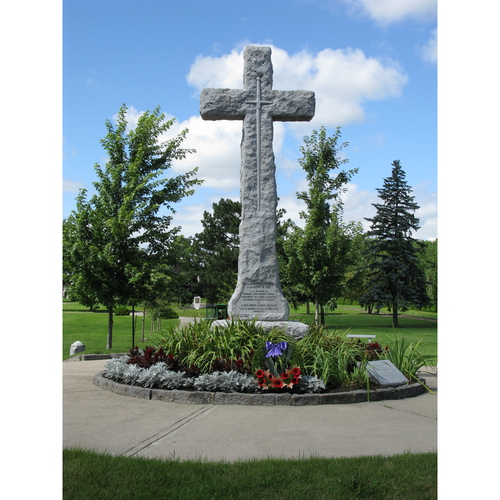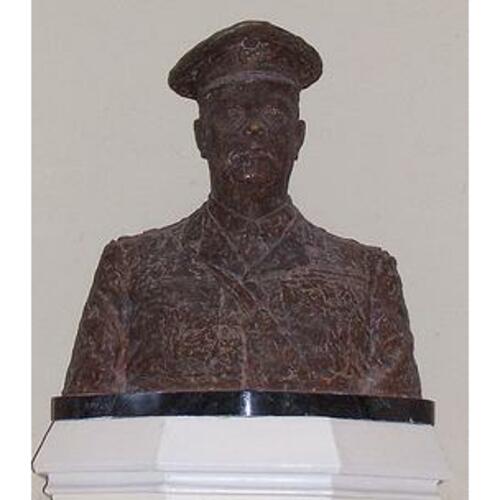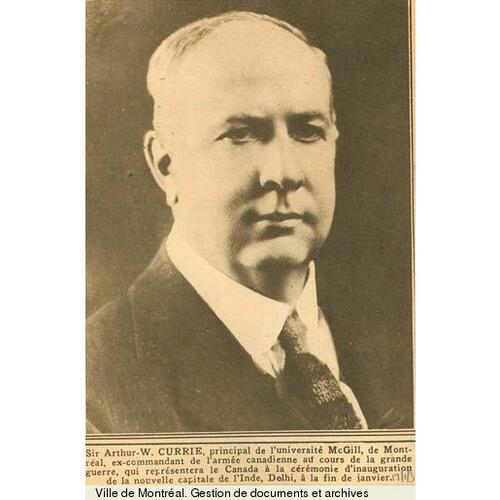CURRIE, Sir ARTHUR WILLIAM, teacher, insurance salesman, militia officer, real-estate developer, army officer, office holder, and university administrator; b. 5 Dec. 1875 in Adelaide Township, Ont., third of the seven children of William Garner Curry and Jane Patterson; m. 14 Aug. 1901 Lucy Sophia Chaworth-Musters (d. 1969), known as Lily or Lillie, in Victoria, and they had a son and two daughters, one of whom died in infancy; d. 30 Nov. 1933 in Montreal and was buried in Mount Royal Cemetery in Outremont (Montreal).
Arthur Currie’s paternal grandparents, John Corrigan and Jane Garner, a Roman Catholic and an Anglican, fled religious intolerance in Ireland to farm in Adelaide Township, Upper Canada. Upon their arrival in 1838, the Corrigans changed their name to Curry and became Methodists. Theirs was a hard life, and of their nine children only four survived to maturity. The elder son, William Garner Curry, married Jane Patterson in 1868, and Arthur was born seven years later. He grew up in a strict Methodist environment (later in life he would adopt Anglicanism), but at school he revealed a playful side, acquiring a reputation as a trickster with an infectious laugh. A good student and a convincing orator, he seemed destined for a career as a lawyer. But his father died in 1891 and Arthur, who was then attending the Strathroy Collegiate Institute, was obliged to lower his sights. He subsequently trained at the model school in Strathroy and received a third-class teacher’s certificate. When he was unable to obtain a position, he returned to the collegiate institute to try for an honours diploma. In May 1894, however – perhaps because of a quarrel with one of his instructors – he abruptly went west, hoping to find fortune on the British Columbia coast.
After a few weeks of adventure but no luck in securing a rewarding job, Arthur was forced to take low-paying positions as a teacher in Sidney and then Victoria. He was happy nevertheless and began to make contacts through sports, religious organizations, and the militia. Sometime after his move to British Columbia, he changed the spelling of his last name (it is said that he did not like his friends and colleagues equating his name with East Indian food and remarking teasingly that “Curry is spicy”). Following his recovery from a stomach ailment that hospitalized him in late 1899, he gave up teaching and started to sell insurance in Victoria. Two years later he married. He was slowly gaining confidence, much of which came from his steady elevation in the insurance business. In 1904 he acquired the agency for which he had been working on commission and in 1906 he was made provincial manager for one of the firms he represented. He was also becoming deeply involved in the local militia. He had joined up in 1897, at the lowest rank of gunner, in the No.5 (British Columbia) Garrison Artillery Regiment. Quickly rising through the ranks, he won a reputation as a disciplinarian, an excellent marksman, and an avid student of military affairs, pursuing courses offered by the professional soldiers at Esquimalt and reading the latest military manuals, treatises, and books. Lieutenant-Colonel Currie was commanding the regiment by 1909. In January 1914 he took charge of the 50th Regiment, an infantry unit he had helped organize; one of his junior officers was his friend Garnet Burk Hughes, the son of the federal minister of militia and defence, Samuel Hughes*.
Currie became a member of several organizations in Victoria, including the Dominion Rifle Association, the freemasons, and the Young Men’s Liberal Club, and he was a recognized businessman whose real-estate and insurance company, founded in 1908, had been making significant profits through speculative buying during the city’s building boom. All booms collapse, however, and by the end of 1912 land speculators and property developers faced bleak prospects as credit dried up and purchasers disappeared. Most of Currie’s funds were now tied up in overpriced property that he could not sell.
The assassination of Archduke Franz Ferdinand, heir to the throne of Austria-Hungary, on 28 June 1914 set off a complicated series of events that drove Europe towards war. When Germany invaded Belgium to make a rapid strike at France, Great Britain was drawn into the conflict on 4 Aug. 1914 through treaty obligations. On that day Canada, as a dominion within the British empire, found itself also committed. A prominent militiaman, Currie would of course play an important role in the war effort. Sam Hughes initially suggested that he should assume the prestigious position of commanding officer of Military District No.11 (British Columbia), where he would be responsible for recruitment and for the training of local units until they were sent to a centralized camp and then to Europe. Currie was going to take the post, since it would allow him to keep a close watch on his dire finances, but his friends thought him too good a soldier to languish as an administrator in Canada; in particular, Garnet Hughes convinced his father that Currie should be sent overseas. The minister then offered Currie command of one of the four infantry brigades that would be forming up for service abroad.
After much soul-searching, Currie accepted, but not before he took over $10,000 from the funds of the 50th Regiment to pay off his debts. This reckless move was a sign of his desperation and would come back to haunt him. In the meantime, on 28 August, Currie left by rail for Valcartier, the site near Quebec City where roughly 35,000 eager Canadians converged to be trained for war. With few supporting staff, Currie had to organize the four battalions in his formation, which had the uninspired name of 2nd (Provisional) Infantry Brigade. Improvisation was the order of the day, but Lieutenant-Colonel Currie nevertheless earned the confidence of the minister, his soldiers, and even Prime Minister Sir Robert Laird Borden, who would later recall that on meeting Currie he had been “impressed.” “He spoke with evident emotion, with apt expression and a thorough appreciation of the duty that lay in front of him and his men. From the first he was an outstanding man among the Canadians.”
The first contingent of the Canadian Expeditionary Force left Quebec City at the beginning of October and arrived in England in the middle of the month. It consisted of a high proportion of British-born soldiers, although it is not possible to determine if these were new immigrants or men who had lived in Canada for years. The troops were anxious to get to France and into the fighting, but their British commander, Lieutenant-General Edwin Alfred Hervey Alderson*, considered them ill prepared, and they would undergo four months’ training on Salisbury Plain, much of it in driving rain and ankle-deep mud. There were problems as well with indiscipline: too much drinking and rowdy behaviour brought the Canadians a reputation as wild men from the north. The contingent also had to deal with faulty equipment, including poor webbing, the much-derided MacAdam shovel, boots that dissolved in mud, and the Canadian-manufactured Ross rifle that was showing a tendency to jam during rapid-fire exercises. Most of the equipment was quickly replaced, although the Ross, which was fiercely defended by Sam Hughes, would be the rifle for most Canadian infantry units on the Western Front until 1916. Despite these problems, a military force was fashioned, with Currie proving himself an adept trainer, hard working and open minded. Alderson later remarked that, of his brigadiers, “Currie is out and out the best.”
Currie took his 2nd Infantry Brigade of some 4,000 men to France with the Canadian Division in mid February. The troops had been lucky to miss the punishing battles of 1914 that had left hundreds of thousands of Germans, British, French, and Belgians dead and maimed. The firepower of modern weapons (rapid-firing artillery, machine guns, and rifles) ruled the battlefield and the only hope of survival for the vulnerable soldiers was to dig into the ground. Over time ditches became trenches, and then vast subterranean shelter systems. Relentless bombardment meant that the underground armies had to rebuild their dugouts every night. With neither the Allies nor the Germans able to manoeuvre around the trenches that ran continuously for more than 400 miles from Switzerland to the North Sea, attacking formations were forced to engage in costly frontal assaults.
The Canadian Division, now about 18,000 strong with three infantry brigades, gunners, engineers, and medical and logistical-support units, began its cycle of tours into the front lines in late February. By April it was in the hated Ypres (Ieper) sector in Belgium, where the Allied position jutted into the German front to form a salient that was bounded by the enemy on three sides and shelled constantly. On 22 April two of Currie’s battalions were in the front lines, with the other two in reserve, while two battalions from the 3rd Canadian Infantry Brigade under the command of Brigadier-General Richard Ernest William Turner* held the trenches further to the west. At 5:00 p.m. the Germans unleashed a cloud of chlorine that drifted through two French colonial and territorial divisions to the left of Turner’s brigade, killing or incapacitating those troops, or sending them fleeing in panic. With an enormous gap on their left, the Canadians counter-attacked, and Currie was instrumental in orchestrating the defence on his sector of the front. By the 23rd all of his soldiers were committed to battle. Outnumbered, outgunned, and equipped with a rifle that seized up repeatedly, the Canadian infantrymen were gradually pushed back. British forces on Currie’s right flank had not yet been attacked and there were thousands of reserve troops milling around in the rear, but shellfire had severed the lines of communication, leaving Currie’s soldiers largely isolated.
A second lethal gas attack on the 24th was directed against the Canadians. Lacking gas masks, his men were slowly repulsed; moreover, later in the day his left flank would become dangerously exposed after Turner unilaterally pulled back his forces in the midst of the confusion. Around noon, with no reinforcements to bolster the hard-pressed troops in the front-line positions, Currie left his post, passing control of his sector of the front to Lieutenant-Colonel Louis James Lipsett*, and tried to rally support in the rear. Dodging artillery and small-arms fire, he stumbled into the headquarters of the British divisional commander on his sector, Major-General Thomas D’Oyly Snow, who refused to accept that the Canadians needed assistance and did not understand why the brigadier had abandoned his post. A dispirited and exhausted Currie, who had fought nearly continuously since the 22nd, went back to the front. In fact, Snow had already dispatched five British battalions to fill the gap on the left, but vindictively did not bother to tell Currie. Eventually the situation was stabilized; after three days of battle, however, the Canadians had endured crippling losses. Currie had proved an adept leader, but he – like most commanders at the front and in the rear – had made mistakes in the chaos, although leaving his lines in search of reinforcements was not one of them. His force suffered more than 1,800 casualties, almost half its strength, by the time it was relieved in early May.
The battle of Festubert later that month revealed again the Allies’ want of experience in launching offensive operations. Plagued by poor intelligence and by wholly inadequate artillery support from commanders in the rear, Currie’s brigade was shattered in fruitless fighting, sustaining more than 1,200 casualties over a few days. A frustrated Currie had pleaded with Alderson to postpone one suicidal frontal assault against entrenched German positions protected by uncut barbed wire, but he had been overruled.
Currie emerged from these two major engagements with the correct belief that the infantry at the sharp end needed to be better served by artillery. Before any attack was begun, enemy positions must be bombarded with high explosives and shrapnel to clear barbed wire, destroy strongpoints, and keep the enemy in his protective dugouts and away from the firing line. Currie understood the challenges of trench warfare and tackled problems methodically; according to one British staff officer, “his common sense stood out,” especially in the realization that his forces had to learn and adapt continually on the Western Front.
After a second division had been raised over the winter of 1914–15 [see Sir Samuel Benfield Steele*], the Canadian Corps was formed in September 1915, with Alderson in command. Currie, who had been promoted colonel and then brigadier-general earlier in the year, was now made a major-general and given command of the 1st Division on the 14th. He surrounded himself with a strong staff, including many experienced British officers, but he also began to encounter civilian meddling, most notably from the recently knighted Sam Hughes, who tried to impose officers in the politicized corps. Currie attempted to block this interference, with mixed results; much of the fight fell to his senior, Alderson, who increasingly clashed with Hughes.
Currie stood out among most generals in the British army. He came from the colonial militia, he was overweight, and he did not wear a moustache. At the same time, he encouraged “a frank interchange of opinions,” which was certainly not always the case among the hierarchical British. Easy-going, he remained comfortable with his staff and was well liked by his officers. Currie had difficulty, however, in transmitting his good qualities to his soldiers, whose temperament he did not understand and who found him stiff, abrupt, sometimes pompous, and occasionally insulting. Moreover, he was a stickler for discipline, especially after the loose behaviour of the Canadian Division in England. He demanded crisp salutes and polished buttons, requirements that did not endear him to the other ranks. His faults combined with the natural resentment of front-line troops against commanders in the rear to produce antagonism towards him in at least some members of the corps.
What the soldiers did not realize was how concerned their uninspiring and sometimes unpopular leader was to avoid needless sacrifices on the battlefield. This preoccupation would become evident in later engagements, where he insisted on thorough planning and preparation, as well as adequate protection for those at the sharp end. As Andrew George Latta McNaughton*, who would rise to command the Canadian Corps Heavy Artillery in 1918, later wrote, “Currie used … organization and covering support of all kinds to the maximum in order to ensure the lowering of the cost of lives.” At the same time Currie never shied away from putting his men into action. His division was the first Canadian one to conduct a trench raid. Such operations were dash-and-destroy affairs, where soldiers sneaked across no-man’s-land, attacked the enemy, and then retreated. They were about gathering intelligence and killing rather than capturing trenches, and the Canadians eventually gained a fierce reputation as expert raiders.
The Canadian Corps received a new commander in late May 1916, after Alderson was removed by the intrigues of Sir Sam Hughes and his friends in London. Hughes had frequently quarrelled with Alderson, but no issue was contested so violently as the British general’s desire to replace the Canadian-made Ross rifle with the British-made Lee-Enfield. Hughes had long been a champion of the Ross and any attack on it – and there were many – was taken as an attack on himself. Although Alderson had been a mediocre leader at best, he deserved a better fate at the hands of the Canadian government. His replacement was another professional soldier, Sir Julian Hedworth George Byng, who was bewildered to find himself at the head of dominion troops, remarking in one letter: “I don’t know a Canadian. Why this stunt?”
The Canadian Corps was scarcely a desirable unit for an experienced and respected general like Byng: the formation, now three divisions strong, had performed erratically and was also shackled by political meddling. Byng barely had time to meet his senior staff before his troops were engaged in a major battle in the southern part of the Ypres salient. On 2 June 1916 German forces opposite the 3rd Canadian Division, which was under the command of Major-General Malcolm Smith Mercer*, unleashed a massive artillery bombardment at Mount Sorrel that shattered the front lines. Entire platoons and sections were killed to a man, and key ground was ceded. A clumsy Canadian counter-attack that day was defeated. An angry and frustrated Byng ordered another one for the 3rd, which fared no better.
Byng then turned to Currie’s senior division to undertake a more methodical assault. Currie marshalled his forces, gathered over 200 artillery pieces, and ensured that his infantry had several days to practise. The attack was launched on 13 June in a risky night operation, but the Canadians cleared the enemy lines, regaining almost all of the lost ground. Currie’s set-piece battle (a term denoting a carefully planned, step-by-step engagement) marked a turning point for the Canadians. It was their first significant and successful large-scale attack of the war, and the British senior staff took notice that victory had been achieved after the gunners had destroyed the Germans’ barbed wire and pulverized their defences, allowing the infantry to cross no-man’s-land and close with the enemy.
To the south, in France, the Somme offensive, begun on 1 July 1916 by General Sir Douglas Haig, the commander-in-chief of the British Expeditionary Force, was not going well. While the British bombardments were of staggering size and ferocity, the Germans had responded by digging deeper into the chalky soil. When the shelling moved off to a different objective, the surviving defenders rose from their dugouts and shot down the attacking infantry that was still trying to traverse the killing ground between the trenches. The cost in lives was horrifying, and there appeared to be no end in sight.
The Canadian Corps arrived on the Somme in early September, and won a limited, although well-publicized, victory at Courcelette on 15 September, but the fighting that followed was of a grinding nature: each side attacked and counter-attacked over the same ruined landscape. Currie’s 1st Division had no distinguishing successes, as thousands of soldiers fell to capture the waste of craters and corpses. When the formation finally limped off in mid October, it had suffered terribly in two major set-piece battles (26 September and 8 October), as well as experienced the ghastly attrition from the shells that fell day and night. There had been little opportunity for Currie to find a solution to the problems at the front because Allied attacks had involved numerous divisions in several corps and therefore required rigid, precisely timed assaults, even when barbed wire was found uncut. It had been nearly impossible to call off an operation that had been planned at army headquarters days in advance. These and other difficulties, including severed communications from front to rear as well as the inability of gunners to target enemy weapons with counter-battery fire, had led to the appalling slaughter, with the Canadian Corps suffering some 24,000 casualties.
The winter of 1916–17 was a critical period for the corps, now enlarged with a fourth division under the command of Major-General David Watson*. Byng ordered all Canadian units to undergo the painful process of examining their successes and failures on the Somme. The corps commander also selected Currie to visit French, and later British, forces and to enquire about their difficult experiences throughout much of 1916, in particular the French ordeal at Verdun. In January 1917 Currie studied the lessons his allies had to offer, questioning and challenging what he was told, separating national puffery from useful battlefield doctrine. He felt that the French could tell the British and Canadians little about gunnery, but that their small-unit infantry tactics, which relied upon decentralized platoons with greater firepower, were an important innovation. Such self-contained fire groups could manoeuvre more easily on the battlefield and fight their way forward even if units on the flanks were slowed down by resistance. Currie codified these lessons in an important report for Byng and they were later disseminated throughout the Canadian Corps. The Canadians were trying to learn from their allies’ gains and losses on the stalemated battlefield, as well as from their own.
Currie had exhibited incredible stamina over the course of the war, pushing himself hard, often staying up past midnight and then rising a few hours later, fuelling himself through frequent recourse to his pipe. His staff learned to be wary around the general when he was exhausted since he could explode and unleash a torrent of profanity. The strain of the war had aged the 41-year-old Currie, whose hair had thinned, whose boyish face was now lined from stress, and who had put on even more weight. He was being worn down by the war, but he knew that his men at the front endured worse.
By February the Canadians were facing the German-held fortress of Vimy Ridge in northern France. They were ordered to capture it as part of a larger Allied offensive, of which the British portion was known as the battle of Arras. The enemy had occupied this key terrain since the start of the war, strengthening its natural defences with deep trenches, miles of barbed wire, and machine-gun nests; at least three previous Allied attacks had failed. Byng rightly believed it could only be captured through careful planning and preparation, destructive artillery fire, and the use of well-trained infantry units advancing to their objectives behind a creeping barrage.
All four Canadian divisions swept forward at 5:30 a.m. on 9 April 1917. Currie had little impact on the battle, which was commanded and fought at lower levels, but he rushed reinforcements to the front to help his division consolidate its gains on the 9th, particularly on the right flank, where British troops had not been able to close the gap. The capture of the ridge by the Canadian Corps on the 10th, with the overrunning of the so-called Pimple to the north by the 12th, was a stunning feat, attributed by Currie “to the disciplined valour of our troops, and to their confidence in their ability to win,” as well as to sound leadership and effective artillery support. Their triumph was all the more significant given that the British to the south failed to meet their objectives after an initial day of success and that the larger French offensive was shattered, causing tens of thousands of long-suffering French soldiers to mutiny in the following months. But it had been no walkover, with more than 10,600 casualties during a four-day period. While all members of the Canadian Corps contributed to the victory, if one is to be singled out it must surely be Sir Julian Byng. It was his achievement rather than Arthur Currie’s, which is only worth noting since there is a common misperception that Currie orchestrated the battle. He did not, although he played an important role as one of the four divisional commanders.
The Canadians emerged from the Vimy battle with a new reputation as shock troops. Over the next three weeks, the corps would push across the Douai Plain, attempting to close with the German army. Sir Douglas Haig, now a field marshal, was obliged by the challenges of coalition warfare to keep ordering his forces forward in frontal attacks against the dug-in Germans so as to divert attention from the dire situation of the French divisions to the south. Amidst shellfire and chemical clouds, the Canadians ran up against two strongpoints, the fortified villages of Arleux-en-Gohelle and Fresnoy-en-Gohelle. Byng called on Currie’s 1st Division to drive the enemy back.
Currie had only a week to prepare for the Arleux battle, which was slated for 28 April, but he ensured that aerial photographs highlighting key terrain were sent to his commanders and ordered the assaulting infantry to practise their advances behind the lines. He also gathered a heavy concentration of artillery and machine guns to support the limited operation that would be fought on a narrow front. His forces captured the German positions on the 28th; they then took Fresnoy on 3 May [see Okill Massey Learmonth*] and held it against determined counter-attacks, although eventually it would be lost after the Canadians handed the position over to British troops. While Currie’s men had been assisted by other formations in the Canadian Corps, these victories were largely seen as a triumph for the 1st Division. Currie knew what sacrifices his soldiers had made in taking their objectives, but he could still allow himself to be pleased at the congratulatory message from the commander of the First British Army, Sir Henry Sinclair Horne: “The 1st Canadian Division is the pride and wonder of the British Army.”
After the success of Vimy and then the minor engagements at Arleux and Fresnoy, Byng was elevated to command one of the five British armies on the Western Front. Haig initially thought of replacing him with another British professional soldier, but the Canadian government, represented in London by Sir George Halsey Perley, the minister of the overseas military forces, maintained that the position of corps commander should now go to a Canadian. Byng had already argued for a Canadian, and his recommendation was Currie. When both the overseas ministry and the cabinet in Ottawa baulked at Currie because he was being imposed on them without consultation, Haig insisted: Currie or a British officer. Arthur Currie was knighted on 3 June 1917 and took command of the Canadian Corps a few days later as a lieutenant-general. In less than three years a lieutenant-colonel leading a few hundred British Columbia militiamen had become a national hero who commanded the embodiment of the Canadian war effort, 100,000 men strong.
Currie acted quickly to find his replacement as commander of the 1st Division. Although Sir Sam Hughes had been removed from the cabinet in November 1916, he was still a force with which to be reckoned as an mp, and he pushed for his son, Currie’s old friend Garnet, to be given the post. Currie refused, believing that there was a better candidate at the front, the battle-tested Archibald Cameron Macdonell*, and he succeeded in having his man receive the position. Currie had declined to compromise the hard-won professionalism of the Canadian Corps, but he had made an enemy of the Hughes family. From this time on, Currie would later write, Sir Sam “never ceased to blackguard me and to minimize my influence and authority with my own men. The things to which he and his associates resorted would bring a blush of shame to the face of every decent citizen of this country.”
Around this time rumours of Currie’s early wartime embezzlement began to circulate in Ottawa, eventually reaching Borden and the cabinet. The ministers were justifiably concerned that the country’s war hero was a court case away from being branded a felon. Currie was forced to borrow money from two senior subordinates to repay the funds. The situation left some Ottawa ministers questioning the character of the overseas corps commander, a man that most of them had never met.
As this affair played out over the summer, Currie was planning his first major operation, near Lens. Haig needed a diversionary attack by the First British Army on this front to draw German reserves away from the third battle of Ypres, better known as the Passchendaele campaign, which was to be launched on 31 July 1917. Currie was ordered to make a frontal assault against the fortified and ruined city of Lens, which would have resulted in heavy casualties in an environment that favoured the defenders. The new corps commander surveyed the battlefield and persuaded his superiors that the attack should instead be directed against Hill 70, which overlooked Lens from the north. His idea was to capture the hill and then set up a kill zone targeted by thousands of rifles, 200 heavy machine guns, and scores of artillery pieces. The Germans would be compelled either to pull out of Lens or to advance into a firestorm. After detailed preparations, the Canadian assault on 15 August worked as Currie had planned. The enemy counter-attacked 21 times over four days [see Learmonth] but never retook the hill, and instead left behind thousands of dead and dying on its slopes. Despite having their forces shattered, the Germans refused to withdraw from Lens. Currie unwisely ordered two probing strikes into the city on the 21st and 23rd, which were beaten back with heavy losses. A more experienced commander might have waited longer to see if his artillery under Edward Whipple Bancroft Morrison* could have dislodged the enemy, but Currie knew that his army commander, Sir Henry Horne, had called for Lens to be taken and he felt the pressure to keep moving forward. Even with this setback, and more than 9,000 casualties by 25 August, Hill 70 was an overwhelming victory for the Canadians.
The corps was moved north in early October to help Haig’s floundering Passchendaele campaign. Heavy rain and unceasing shellfire had reduced the battlefield to a bog. In three months of fighting the British army had inched forward only a few miles at the cost of some 200,000 casualties. Currie did not want his men committed to the forlorn battlefield, but Haig insisted. While Currie was accountable to Canadian politicians as leader of the dominion’s primary land force, he also served in the BEF. He could not very well ignore Haig’s orders, but he was able to use his status as a de facto national army commander to extract extra guns, an agreement that the battle would be planned on his timetable, and a guarantee that his men would not fight in General Sir Hubert de la Poer Gough’s 5th Army, with which the Canadians had fought on the Somme and which had a reputation for callously throwing soldiers into battle without adequate preparation. Haig agreed, although he was taken aback by Currie’s demands, especially his refusal to serve under Gough.
Currie knew that success at Passchendaele could only be attained through set-piece battles that relied on the close interaction of artillery and infantry. Tanks were useless in the mud. Intense pre-battle work by the engineers under Brigadier-General William Bethune Lindsay on building roads over the morass and digging new gun-pits for the artillery and mortars ensured that the infantry and machine-gunners going into battle were better supported. Many must have wondered nevertheless how they were to prevail in mud that was up to their waists in places. An all-out assault would never work. Currie planned for the attack in four phases, each having limited objectives so that the infantry could advance but still remain within the range of their protective artillery. The operation on the 26th pulled the Canadians out of the mud and up the ridge; the battles of 30 October and 6 November captured numerous strongpoints and the ruined village; a final push on the 10th allowed the corps to consolidate the ground. With Hill 70 and Passchendaele, Currie had proved himself an adept leader in command of a hard-hitting fighting force that could deliver results on the most difficult of battlefields. Its string of achievements, Currie said, “testifies to the discipline, training, leadership and fine fighting qualities of the Canadians. Words cannot express the pride one feels in being associated with such splendid soldiers.”
But there were no bloodless victories on the Western Front. The Canadian Corps lost roughly 30,000 men from August to November. Although Currie had, in the words of Brigadier-General Victor Wentworth Odlum*, “earned a reputation among the Members of the High Command as one of the most careful and humane leaders in the Field,” the casualties were not easy to overlook, or replace. Back in Canada, the country was in the middle of the divisive conscription debates that would culminate in the federal election of December 1917. Currie was pressured by Borden’s new Unionist coalition – formed from Conservatives and many pro-conscriptionist Liberals – to come out in favour of a compulsory draft of young men for overseas service, and while Sir Arthur fervently wished to avoid becoming involved in political battles, his loyalty was first to his troops, who needed reinforcements. When Currie publicly supported conscription, he was smeared by Liberal candidates on the hustings: they labelled him a butcher who was careless with soldiers’ lives. These were unfair charges and Currie felt betrayed, but he seems to have little realized that his increasingly high profile as corps commander required him to navigate political waters.
The enemy was in the ascendant during the first months of 1918, Russia having been knocked from the war late the previous year. The Germans diverted dozens of combat divisions from the eastern theatre of operations to launch an offensive on the Western Front in the hope of driving the Allies to the negotiating table before the United States, which had come in on the Allied side in April 1917, could bring the weight of its forces to bear.
In these months as well the British faced a manpower shortage and Haig was forced to cut his infantry divisions dramatically, from 12 battalions to 9. This decision was grim for morale and reduced combat effectiveness, since fewer soldiers could be committed to a battle and they could operate only for shorter periods. Currie was urged by the British War Office and the Canadian Ministry of the Overseas Military Forces to follow suit. Combining the soldiers from his disbanded battalions with the men of Garnet Hughes’s 5th Infantry Division in England would allow for the creation of two smaller Canadian corps, each comprising 27 battalions in three divisions. Such a reorganization would create new positions and give Canada more prestige. Many Canadian officers and politicians pushed for two corps, with some even suggesting that a Canadian army might be formed. Currie would surely have been made army commander, and would have been the only dominion officer to reach that rank in the empire’s forces. But Currie surprised everyone by refusing to accept a reduction of his battalions. Putting the corps ahead of his own self-interest, he argued strongly that such a shuffle would add little to the striking power of the Canadians and would in fact leave them weaker; two corps would be cycled into the line more frequently than one, would therefore suffer casualties over and above the normal rates of attrition for one corps on the Western Front, and would then be more vulnerable since there would be fewer reserves in England. Currie prevailed with the minister of the overseas military forces, Sir Albert Edward Kemp*, and even strengthened his existing fighting formations by having the 5th Division broken up to use as reinforcements, as well as by poaching its guns and heavy machine-gun units to give his corps additional firepower. Although Currie’s decision was highly unpopular with some place-seeking officers, it was undoubtedly the right one. The Canadian Corps did not need another division of 20,000 men; it needed the 20,000 trained soldiers to reinforce the four extant divisions, and to act as a reserve for the casualties that were expected in future engagements. His obstinate struggle ensured that the corps could indeed survive the costly fighting in the coming year and was one of the most important battles of his career.
With intelligence warning of a German offensive in March, Currie ordered his Canadians to fortify Vimy Ridge and the surrounding area, where the corps had been dug in over the winter. Further up the line, however, many dispirited British formations failed to prepare their defences adequately. When the Germans unleashed a hurricane bombardment of shells and poison gas on 21 March, their driving infantry units overwhelmed British positions and flowed around areas of resistance, leaving the defenders of these strongpoints caught behind the enemy lines. Currie believed that many of the problems faced by the British troops were a result of poor generalship in the rear. His own forces largely escaped the onslaught.
Despite harsh fighting and heavy casualties, the Allies survived the offensive, eventually blunting the enemy’s deep assaults. Most of Currie’s forces were pulled from the line in May and they underwent a period of rest as well as intense training in reserve. Currie knew that, having escaped the worst of the battle at Vimy, his oversized corps would be called upon at some point to lead the British strategic counter-attack. As his soldiers made ready for battle, the general was asked to meet Borden in London in June 1918. The prime minister did not know his corps commander well, but he turned to Currie for advice on the war, which seemed to have gone badly since the Somme. Currie was put in a difficult situation: he served two masters and now they were potentially pitted against each other. He nevertheless spoke freely to Borden, who noted that the general’s revelations were “very depressing”; “I am convinced,” Borden continued, “that the present situation is due to lack of organization, lack of system, lack of preparation, lack of foresight and incompetent leadership.” Borden used Currie’s information as ammunition in a fiery meeting of the imperial war cabinet on 13 June. The British prime minister, David Lloyd George, accepted Currie’s assessment gratefully since he despised many of his country’s professional soldiers, reserving special bile for Haig. In fact, Lloyd George seems to have toyed with the idea of removing Haig and replacing him with Currie, although the only evidence of such musings is in the British prime minister’s multi-volume memoirs written more than a decade later; Currie’s papers contain no reference to the possible promotion. The appointment of a dominion militiaman over the five army commanders and a dozen or so more experienced corps commanders would have led to a revolution in the British forces. If such an appointment was a pipe dream of the disheartened Lloyd George, who was trying to shake up the inertia he saw in the army, it was also a sign of Currie’s high standing, at least among British politicians.
Haig ordered a major counter-attack at Amiens in August and the Canadians would play a spearhead role. Currie’s involvement was limited to the elaborate plan of secrecy and misdirection that preceded the battle. It succeeded and the enemy was unaware of the large Canadian build-up in the area. On 8 August Canadian and Australian forces, supported by British and French formations, crashed through the German lines, nearly breaking the deadlock on this front. Currie pushed his men ahead on the following day but the enemy had recovered and rushed reinforcements forward. The logistical lines were strained and the infantry often found themselves engaged in frontal assaults without adequate artillery support. Currie went to his superiors on 13 August to recommend that they call off the battle, given that no breakthrough was now possible. The British generals listened to him and the offensive was halted. While the Canadians had killed thousands and captured more than 9,000 prisoners, they had suffered almost 12,000 casualties before they withdrew on 20 August.
Currie was able to make good his severe losses with reinforcements, many of whom were conscripts, but his corps now faced a far more difficult series of fortifications to the east of Vimy Ridge. The Hindenburg Line ran along this sector, consisting of a series of trench systems, defended villages, and concrete strongpoints more than 18 miles deep. The Canadian Corps attacked here at Arras on 26 August behind a sledgehammer artillery barrage. After the initial rupture of enemy front lines, there was much brutal fighting. Currie’s plan involved having two of his divisions fight for the first three days, with rotating formations bearing the brunt of each day’s battle. By the morning of the 28th, however, his forces were nearly broken. Unable to put new troops into the line immediately yet wanting to keep pressure on the enemy, he ordered his tired soldiers forward, hoping they might succeed. Some did, through incredible acts of bravery and self-sacrifice [see Archibald Ernest Graham McKenzie*]; too many were torn apart by enemy fire as they ran up against uncut barbed wire. Currie had gambled here and failed – and his men paid for it. Fresh divisions took over on the 29th, and on 2 September the Canadians finally cracked the vaunted Drocourt-Quéant Line, a branch of the Hindenburg defences. After prolonged, close-quarters fighting, they had achieved success but at the cost of another 12,000 casualties. The Canadian Corps blade was becoming dulled from overuse.
The Canadian soldiers might well have believed that they had earned a rest, but the Germans seemed to be crumbling up and down the line and the corps was instead given the objective of crossing the Canal du Nord, just to the east of the Drocourt-Quéant Line, breaking through several trench systems, and capturing the city of Cambrai, an important logistical centre. The Germans had flooded much of the region around the canal, turning it into a morass. Currie did not want to subject his men to another Passchendaele and was relieved when his intelligence officers found a narrow gap of dry country, about 2,600 yards wide, through which to push the corps. It would be an extremely dangerous operation, however, for if the first-wave troops were held up by resistance, the Canadians would be annihilated as the enemy brought their crushing firepower to bear on the limited front.
This route was the only way forward, but even Currie’s army commander, Sir Henry Horne, pleaded with him to reconsider, thinking the plan too risky. Although Currie had faith in his soldiers, he was surely gambling again, and any reversal with heavy casualties would likely have resulted in his dismissal. Currie’s troops had about three weeks to prepare for an operation that would again take a combined-arms approach with the artillery and infantry working together, supported by engineers, air power, armoured cars, mortar teams, and independent machine-gun formations. Behind a fierce barrage and accurate counter-battery fire, the corps broke through the gap on 27 September, pushing across the potential killing ground on the other side of the canal and then fanning out, with the foot soldiers overrunning enemy trenches and capturing villages [see Roderick Ogle Bell-Irving*; Samuel Lewis Honey*]. There were no easy victories, but by 1 October the Canadians were on the edge of Cambrai. With the city almost in Allied hands, the French high command begged Haig not to bombard it. Currie refused to send his forces to capture the city without a protective barrage, and so the Canadians stood firm for a week. While preparations for an assault were finally being made, the Germans retreated on the 8th. Currie’s forces had won another stunning victory, but again at staggering cost. In September alone they suffered over 18,000 casualties; by the end of October their losses totalled almost 27,000. Yet, Currie wrote to Kemp on 1 November, “I do not consider that anyone can regard them as excessive when the extent and severity of the operations are considered. You cannot meet and defeat in battle one-quarter of the German Army without suffering casualties.”
The Canadians chased the Germans eastward for the final month of the war, but there were no large-scale battles other than the liberation of Valenciennes from 1 to 2 November [see Hugh Cairns*]. Nevertheless, the deaths and injuries continued to mount in countless small skirmishes against determined rearguard forces. Despite his soldiers’ exhaustion, his superiors ordered Currie to press on, believing, as he also did, that the Germans were even worse off. They were, but that did not mean much to those troops driven forward. The Canadian Corps’s capture of the city of Mons, Belgium, on the last day of the conflict was a significant symbolic victory, since it was the city from where the British professional army had started its long retreat in August 1914. Currie’s superiors feted him, even as some of his men in the front lines questioned the need for such sacrifices at the end of a very long and punishing war. News of the impending attack on Mons had produced a strong reaction in Corporal William Richard Bird*’s platoon, one of his men reportedly exclaiming, “This war’s over tomorrow and everybody knows it. What kind of rot is this?” After the battle another soldier, who lost his brother in it, threatened to shoot Currie if he saw him.
During the 96 days of battle, from 8 August to 11 November, that formed the campaign known as the Last Hundred Days, the Canadian Corps achieved a string of remarkable successes. “To my mind …,” Currie wrote to Borden, “no force of similar size played anything like so great a part in bringing the proud enemy to his knees.” Yet the corps also suffered 45,800 casualties, an eighth of the total for the entire BEF (including all its logistical troops) in this period, though in numbers of men it formed only about 15 per cent of the combined infantry. The Canadian Corps cemented its reputation then, but it was a costly victory.
Following the armistice of 11 Nov. 1918, two Canadian divisions were selected to be a part of the army of occupation in Germany. Anxious to go home, the troops were quarrelsome and receptive to rumours. One of the more prevalent notions centred on Currie as a cold-blooded general who had sacrificed his soldiers to raise his own reputation in the eyes of his British superiors. The staggering losses of the Last Hundred Days were proof, it was said, of Currie’s callous nature. Informed of the rumours, Currie felt they had been instigated by the Hughes family and their minions. Yet although Sir Sam Hughes had been blackening the general’s reputation in Canada through an aggressive whispering campaign since mid 1917, it appears that many of the stories circulated freely among Currie’s men too. As one of the general’s closest friends concluded, “The cruel fact [is] that this propaganda against the Corps Commander was fostered, if not begun in the literal sense, within the CEF.” Currie and many of his loyal officers thought that only a disenchanted minority was responsible.
Whether there was any truth to the insinuations is a moot point. Currie had not wantonly sent his men off to their deaths; yet he had not spared them from battle either. His corps was bigger in 1918, had more firepower, and could better withstand the relentless pounding of prolonged combat. It is impossible to measure whether the casualties sustained were excessive, but enough of Currie’s men believed that they were for the stories to continue to spread. Just as the reputation of the Canadian Corps had been secured during the Last Hundred Days, so Currie’s personal reputation had simultaneously been damaged.
Currie refused to engage with the rumours, noting to Sir Edward Kemp and other friends in the corps and back in Canada that he could not run them to ground, nor did he want to acknowledge them openly. He hoped instead that the government would defend him publicly. It did not, likely because there had been no outright accusations. This situation was soon to change. On 4 March 1919 Currie’s problems were compounded when Hughes, with the protection of parliamentary immunity, denounced him in the House of Commons for “needlessly sacrificing the lives of Canadian soldiers,” suggesting that any general who ordered the assault on Mons on the last day of the war should be “tried summarily by court martial and punished so far as the law would allow.” It was a shocking charge. Newspapers and veterans’ groups reacted angrily, but no member of the house immediately stood up to refute Hughes. His allegations hung like a pall. For some, they were little more than a mean-spirited attack by a discredited politician. But in those who anguished over the more than 60,000 battlefield dead, the suspicion arose that perhaps the former minister knew something that they did not.
Currie was exhausted from his wartime ordeal and, as is evidenced in his correspondence from this period, likely suffering from some form of what is now identified as post-traumatic stress disorder. After more than four years of combat, he simply did not have the strength to fight Hughes’s “foul lies.” “I cannot see how I can stop him,” he wrote to a friend from Germany. “The man is a liar, is at times insane, and apparently is a cur of the worst type.” Although a few members of parliament countered Hughes’s accusations, ministers remained silent. Currie had been out of the country for nearly five years, he had few political backers, and most politicians did not want to tangle with Hughes, who was still a powerful force. When Borden’s cabinet finally responded, on 27 May, Sir Edward Kemp referred only briefly to Currie’s achievements, commenting tepidly that the general had been “ever considerate of the men under him.” Currie regarded the defence as not staunch enough. In July, after the prime minister, who had been attending the peace conference in Versailles, France, at the time of Hughes’s denunciation, returned to the house, he mounted a somewhat more vigorous one, saying of the charges, “No criticism could be more unjust.” Still, the vote of thanks to the Canadian armed forces proposed that day made no mention of Currie personally, referring only to the “General Officer Commanding” the Canadian Corps.
With the greater part of the corps demobilized by the early summer of 1919, Sir Arthur and Lady Currie, who had moved with the children to England in 1915, returned to Canada, arriving in Halifax just after midnight on 17 August. Their ship had been expected earlier, and the bands and well-wishers had gone home. Since it was a Sunday, there were only subdued celebrations later in the day; the Halifax Morning Chronicle reported disapprovingly that while a guard of honour and hordes of officials were present, the general was received in solemn silence. Currie’s train to Ottawa was greeted by throngs of admirers at the station, but when he and his entourage were taken to the Victoria Memorial Museum, Canada’s temporary parliament after the fire of 1916, there were again reserved crowds. Even more disappointing was the absence of Borden – acting prime minister Sir George Eulas Foster filled in – and several prominent ministers, who had gone to Saint John to greet the Prince of Wales. At the temporary parliament the atmosphere was cold and it was reported that a small group of women were heard to hiss at Currie’s name from the gallery. It appeared to the general that Hughes’s charges still hung heavily in the air. Despite this chilly atmosphere, Currie was no social pariah. When he embarked on a speaking tour in late September, he was met by cheering crowds wherever he went. A powerful and charismatic orator, he devoted many of his speeches to what the Canadian Corps had accomplished during the war, and especially in the Last Hundred Days, no doubt to explain in part the casualties from this time of intense battle.
Although the cabinet voted against giving Currie a cash grant, such as had been awarded in Britain to the senior generals there, he had been offered the position of inspector general of the armed forces, to which he was appointed on 23 Aug. 1919 and which he took up on 10 December, with the rank of full general. This new post was the highest in the Canadian forces and Currie planned to use it to reform the military. He was stonewalled at every turn. Funds were cut and he encountered opposition from a military bureaucracy that, with some exceptions, saw him as an outsider. Currie blamed older officers who had stayed in Canada during the war, many of whom held top places in the Department of Militia and Defence and in militia districts across the country. Deeply unhappy, he had the sense that the government simply wanted him to accept the post as a sinecure. This he refused to do. Currie escaped the drudgery by leaving the Canadian military to become principal and vice-chancellor of McGill University in Montreal.
His academic elevation may have seemed odd, given that Currie had made his name as a military man and had no more than a high-school diploma. He had been chosen, acting principal Frank Dawson Adams* said, because of his “exceptional powers of organization and administration” and his “capacity for inspiration and leadership.” Accepted warmly at McGill when he arrived in May 1920, he rapidly gained the respect and affection of both staff and students, having, as one of his secretaries commented, “the great gift of knowing and understanding human nature,” an attribute that was combined with a prodigious memory for names, a firm but fair disposition, a penchant for prompt decision-making, and an ability to admit his own mistakes. Willing to work and quick to learn, he soon mastered his new environment in a way that impressed even critics of his appointment, and within months of his arrival he led a massive fund-raising campaign to revive the moribund institution, travelling from coast to coast in a personal appeal for support. That almost $1.5 million was subscribed over the original goal of $5 million was, said Professor Sir Andrew Macphail, “a tribute to himself as much as to the university.” Financially secure in his new job, his salary enhanced by a directorship in the Bank of Montreal, he made a name as one of the country’s premier university administrators. From 1925 to 1927 he served as president of the National Conference of Canadian Universities [see Sir William Peterson*], and he was also a trustee of the Carnegie Foundation for the Advancement of Teaching. At McGill, new buildings were erected, additional departments created, staff salaries increased, and research and teaching facilities expanded. The faculty of medicine in particular progressed, the result in part of the close collaboration between Currie and its dean from 1923, Charles Ferdinand Martin. Although the university would again fall upon hard times by the 1930s, Currie worked with Martin to keep neurosurgeon Wilder Graves Penfield* at McGill, helping to raise funds for the Montreal Neurological Institute and taking charge of its building program; in 1933 he presided over the laying of the foundation stone of the institute, which opened the next year. A warm friend to the Royal Victoria College for women [see Ethel Hurlbatt], he was instrumental in saving the university’s School for Graduate Nurses from closure in the early 1930s [see Bertha Harmer]. The university’s chancellor, Edward Wentworth Beatty*, would note in his report for 1933–34 that McGill had doubled its income while Currie was in office, despite the difficulties brought on by the Great Depression. Over the years Currie’s contributions both to education and to the war effort were recognized in 19 honorary degrees.
Throughout the 1920s Currie had remained a prominent Canadian and he frequently attended the erection of war memorials or was consulted by the government on military issues. From 1923 to 1932 he served as president of the Last Post Fund, established in 1909 under the presidency of John Macpherson Almond to ensure that no veteran was denied a decent burial because of lack of resources. During his tenure the fund opened its first military cemetery, the Field of Honour in Pointe-Claire, Que.; the Cross of Remembrance, unveiled there in 1934, would be dedicated to Currie and “our warrior dead.” In contrast, Currie was initially little involved in the splintered veterans’ organizations, many of which he saw as being led by radicals who did not want senior officers in their fraternity.
Currie had easily made the transition from soldier to educator, but he continued to worry about the lasting effects of Hughes’s accusations. Although Sir Sam had attacked Currie a few more times in the House of Commons, his death in 1921 seemed to have buried the issue for many Canadians. Currie felt it did not, partly because he had been unable to refute the allegations fully. He found his opportunity in 1927 when a small-town newspaper, the Evening Guide of Port Hope, Ont., published a scathing editorial on 13 June repeating the substance of Hughes’s charges. Currie was again described as a butcher for ordering the attack on Mons on the last day of the war, “a shocking useless waste of human life.”
An enraged Currie weighed his options. Colleagues told him to drop the matter: the readership of the newspaper was insignificant and he would only damage his reputation by responding to such denigration. But Currie was deeply hurt and believed that now he might finally put an end to the rumours that had dogged him for almost a decade. He assembled a legal team and sued the newspaper’s owner, Frederick W. Wilson, and the writer, William Thomas Rochester Preston*, for libel. The trial ran in Cobourg for 16 days from mid April 1928 to early May and was covered by a horde of journalists for newspapers across the country, in the United States, and throughout the British empire. The defence had little evidence to establish the veracity of the editorial, and so the strategy of Wilson’s lawyer, Frank Regan – Preston conducted his own defence – was to attack Currie’s reputation. While the case should have been centred solely on Currie’s decisions at Mons, since they were the substance of the article, Regan questioned the general’s conduct during the entire war, trying to embarrass him into dropping the suit. Day after day, Regan made sensational claims, almost all of which were unfounded and unsupported by official records or soldiers’ testimonies. The defence was devastating for Currie to sit through, and the intense examination of his wartime actions nearly broke him. The verdict finally came down in his favour, but although he had asked for $50,000 in damages, he was given a mere $500. The jury, consisting largely of farmers and labourers, had been instructed by the judge that they could adjust the amount paid in damages and they may have thought that $50,000 was simply too high. While there were pundits at the time who interpreted the $500 as an indication of a flawed victory (as have some historians since), for Currie the cash award was secondary to the seeming restoration of his reputation. Currie was lauded across the country, with many newspapers and friends suggesting that Sir Sam Hughes’s allegations and the ever-present rumours had finally been answered decisively.
Currie returned to Montreal a hero. Shortly after the trial, however, the 53-year-old had a stroke. Granted an extended leave of absence from McGill, he recovered slowly. In the last years of his life, he reconciled with the veterans’ organizations. He was elected dominion president of the Canadian Legion of the British Empire Service League in 1928 and, when ill health obliged him to resign the following year (he was succeeded by Léo Richer La Flèche*), he was made honorary grand president, a position he held until his death. An important champion for the veterans, he focused on pension reform in the late 1920s, declaring himself in 1929 “not only amazed but ashamed that eleven years after the war it is necessary not only to plead but to fight for justice.” Although some veterans found him too conciliatory, the prestige of his advocacy helped lead to the establishment, by the government of Richard Bedford Bennett*, of the Canadian Pension Commission in 1933. To the surprise of many friends, Currie embraced disarmament in these years, speaking about the need for international dialogue rather than rearmament, a stance that sometimes led him into fierce discussions with soldiers and veterans.
Currie again suffered a stroke on 5 Nov. 1933, and he died on the 30th in the Royal Victoria Hospital (of which he had been a governor, as he was of the Montreal General Hospital) from bronchial complications brought on by pneumonia. His civilian and military funeral on 5 December was held in Montreal, and was the largest to that point in Canadian history. An estimated 250,000 watched the funeral procession, and tens of thousands more listened to an account of it on a coast-to-coast radio broadcast. In London on the same day a memorial service was conducted in Westminster Abbey, which was filled to capacity. Three years after his death Currie’s remains were removed from the family plot to a more prominent site in Mount Royal Cemetery, where a cross of sacrifice was raised on the third anniversary of his funeral. Lady Currie would survive her husband by 36 years. The depression having severely affected his personal finances, she was left in some difficulty when McGill decided it could not afford to continue paying her a portion of his salary. In 1935 the Canadian government finally recognized his “eminent service” monetarily by granting $50,000 to his estate, an action, Prime Minister Bennett said, “that should have been taken … at the conclusion of the war.” The leader of the opposition, William Lyon Mackenzie King*, concurred in the “belated recognition of … one of the most distinguished of Canada’s sons.” The year before his death Currie’s daughter, Marjorie Chaworth-Musters, had married Montreal architect Alexander Tilloch Galt Durnford; his son, Garner Ormsby, who would serve in World War II, pursued a career in the federal civil service.
Although the Great War had surely made Sir Arthur Currie, it was largely responsible as well for putting him into an early grave. But his reputation lives on. He is regarded in most history books as one of the finest generals of either side in the war. His ascension to the position of corps commander in June 1917 is often conflated with the emerging sense of a national identity from the battlefield victories on the Western Front. In 2004 the Canadian Broadcasting Corporation ran a contest to find “the greatest Canadian,” and Currie ranked 24th out of 100 among those who voted. Two years later a statue of him was unveiled as one of the 14 historical figures that form the Valiants Memorial in Ottawa, erected near the National War Memorial. Sir Arthur Currie remains a widely recognized Canadian and one closely linked to Canada’s coming of age during the costly battles of 1914–18.
Sir Arthur William Currie’s papers are spread throughout three institutions, with the largest and most complete collection at LAC in the Arthur William Currie fonds (R7180-0-5). The Canadian War Museum in Ottawa has a small assortment of military documents and correspondence in Fonds of General Sir Arthur Currie (19801226-267), as well as ephemera in other collections. MUA in Montreal holds Currie’s papers in MG 1030; his official files as principal are in McGill Administrative Records (RG 2). As well, the research notes and correspondence amassed by his first biographer, Hugh MacIntyre Urquhart, and assembled in his papers (MG 4027), contain important observations by Currie’s colleagues in the aftermath of his death. Materials from the LAC and war museum collections have been published in The selected papers of Sir Arthur Currie: diaries, letters, and report to the ministry, 1917–1933, ed. M. O. Humphries (Waterloo, Ont., 2008).
There are three Currie biographies: D. G. Dancocks, Sir Arthur Currie: a biography (Toronto, 1985); A. M. J. Hyatt, General Sir Arthur Currie: a military biography (Toronto, 1987); and H. M. Urquhart, Arthur Currie: the biography of a great Canadian (Toronto and Vancouver, 1950). Currie’s 1928 trial is covered in R. S. Demill, “The 1928 Cobourg libel trial of Sir Arthur Currie and the Port Hope Evening Guide: the rehabilitation of the reputation of a corps commander” (ma thesis, Univ. of Ottawa, 1989) and R. J. Sharpe, The last day, the last hour: the Currie libel trial ([Toronto], 1988). All histories of Canada in the Great War have sections devoted to Currie; see in particular Tim Cook, At the sharp end: Canadians fighting the Great War, 1914–1916 (2v., Toronto, 2007), 1; Shock troops: Canadians fighting the Great War, 1917–1918 (2v., Toronto, 2008), 2; The madman and the butcher: the sensational wars of Sam Hughes and General Arthur Currie (Toronto, 2010); and J. A. Swettenham, To seize the victory: the Canadian Corps in World War I (Toronto, 1965). There are several articles devoted to Currie. The most important include R. C. Brown and Desmond Morton, “The embarrassing apotheosis of a ‘great Canadian’: Sir Arthur Currie’s personal crisis in 1917,” CHR, 60 (1979): 41–63; A. M. J. Hyatt, “Sir Arthur Currie and conscription: a soldier’s view,” CHR, 50 (1969): 285–96; and T. H. E. Travers, “Allies in conflict: the British and Canadian official historians and the real story of second Ypres (1915),” Journal of Contemporary Hist. (London), 24 (1989): 301–25.
There are at least a dozen portraits of Currie, most of which are at the Canadian War Museum or McGill Univ. Photographs documenting Currie’s military career can be found in his fonds at LAC and especially in the official military photographs compiled by the Canadian War Records Office (of which the originals are held at LAC), with a nearly full set of prints at the museum. Many of these have been digitized and are available on the museum and LAC websites. Several of Currie’s artefacts, including his medal set, sword, uniform, and desk, are held at the museum.
Cite This Article
Tim Cook, “CURRIE, Sir ARTHUR WILLIAM,” in Dictionary of Canadian Biography, vol. 16, University of Toronto/Université Laval, 2003–, accessed December 30, 2025, https://www.biographi.ca/en/bio/currie_arthur_william_16E.html.
The citation above shows the format for footnotes and endnotes according to the Chicago manual of style (16th edition). Information to be used in other citation formats:
| Permalink: | https://www.biographi.ca/en/bio/currie_arthur_william_16E.html |
| Author of Article: | Tim Cook |
| Title of Article: | CURRIE, Sir ARTHUR WILLIAM |
| Publication Name: | Dictionary of Canadian Biography, vol. 16 |
| Publisher: | University of Toronto/Université Laval |
| Year of publication: | 2013 |
| Year of revision: | 2013 |
| Access Date: | December 30, 2025 |


